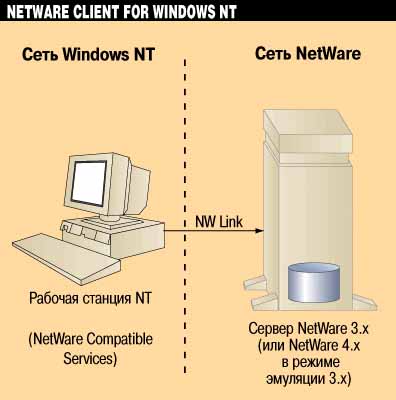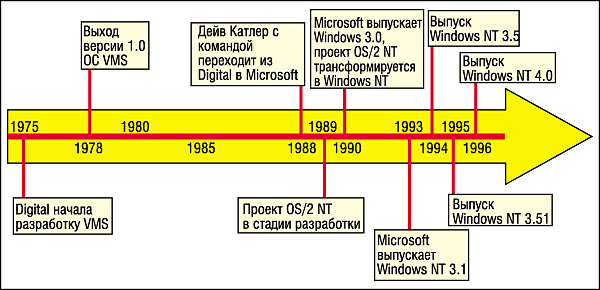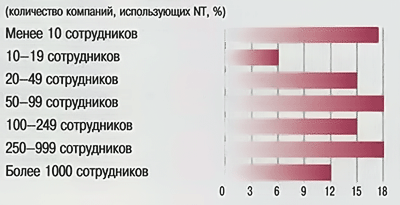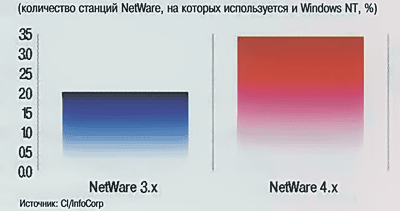How Windows NT Became the “Killer” of Novell NetWare OS

Novell NetWare network operating system was once the global market leader. Once the most progressive ideas were laid in its basis. However, in the IT industry, everything is quickly becoming obsolete, and competitors never sleep.
Microsoft Windows NT is a younger OS compared to NetWare. Bill Gates Corporation could not miss the market for network operating systems. Having joined the fight later, but with its characteristic scope, Microsoft began to quickly master the market and was able to avoid some of the mistakes of the pioneers.
')
Novell NetWare
Work on the future NetWare OS began in SuperSet Software, a consulting group founded by friends Drew Major, Dale Niebauer, Kyle Powell and Mark Hirst. They used their insights from Brigham Young University in Provo, Utah, in October 1981.
SuperSet Software was founded in 1979 and was engaged in the production of systems running OS CP / M. The group was supposed to create a disk sharing system for CP / M based networks.
CP / M (Control Program / Monitor or Control Programs for Microcomputers) is an operating system originally designed for 8-bit microcomputers. Written in 1973 by programmer Gary Kildall in the programming language PL / M (Programming Language for Microcomputers).In the course of the work, the group concluded that the future prospects of CP / M are zero. The team decided to develop its operating system for IBM-compatible PCs, which then only appeared and were “on the crest of a wave”. The result is a network operating system that was later called Novell NetWare.
In 1983, Raymond Noord joined the work of the SuperSet group, becoming the head of the young company Novell Inc.

In the same year, the company launched the first commercial product - NetWare 68 (or Novell S-Net). It worked on the basis of the Motorola 68000 processor. In 1985, NetWare 86 came out, which supported the Intel 8086 processors.
In 1986, after the release of the Intel 80286 processor, Novell released NetWare 286. And in 1989, Intel 80386 and NetWare 386 appeared. Later, Novell decided to give its systems simpler version numbers: for example, NetWare 286 became NetWare 2.x , and NetWare 386 is NetWare 3.x.
NetWare success reasons
To transfer packets to NetWare, NCP (NetWare Core Protocol) protocol was used. It was developed based on the previously popular IPX / SPX (Internetwork Packet eXchange / Sequenced Packet eXchange) protocols developed by the same Novell.
NCP was used to organize the exchange between the workstation and the file server. The IPX protocol provided the network layer (packet delivery, IP analog), SPX provided the transport and session layer (TCP analog). True, in the fifth version of NetWare, the manufacturing company still made TCP / IP support for the NCP protocol, not IPX / SPX.
NetWare reached its peak in the 80s and 90s. It was a convenient system at the time, and very stable: servers running NetWare could work for years without administrator intervention.
Also, a significant role was played by the fact that most of the benchmarking tests at that time indicated a performance advantage in the ratio from 5: 1 to 10: 1, as compared to the products of Microsoft and other companies. This effect was achieved through the use of file services instead of disk services, the effectiveness of the NCP protocol and the absence of preemptive multitasking.In 1993, counting on quick success, Novell released NetWare 4.0 and NDS (then called the NetWare directory service), but they were not met with open arms. New products embodied the implementation of a new approach to the organization of network computing in the enterprise and were very different from everything that NetWare 3.x users were used to. Therefore, the most popular version for a long time remained exactly 3.x.

However, the directory service (NDS), part of NetWare 4.x, later became the industry standard in a corporate environment.
Windows NT
The strongest competitor to Novell NetWare has become the Microsoft Windows NT network operating system.
It all started in 1975. It was when Digital Equipment began developing its 32-bit VAX platform, which was later taken up by Microsoft.
In 1977, the VAX-11/780 machine and its operating system, VMS 1.0, were announced. The development of the system was led by David Cutler. Four years later, he decided to leave Digital: he was not satisfied with the pace of development of the project.
Then the company organized an autonomous unit in Seattle, and Cutler was allowed to recruit the necessary number of staff (about 200 people) directly from Digital employees. The new structure took up the design of processor architecture and operating system, code-named Prism.
However, the managers failed to bring the matter to a logical conclusion, and in 1988, Cutler left the company.
That's when Bill Gates invited him to Microsoft. By that time, he had just come to the need to create a server OS competing with Unix clones.
Gates so appreciated David Cutler that he agreed to hire 20 former Digital engineers with him. In November 1988, a team that included five people from Digital and one Microsoft programmer began working on a new operating system. Of course, she was not completely new, as Cutler used his work.
It was necessary to write an OS for the new Intel i860 RISC processor, codenamed N-Ten. From here, by the way, the abbreviation NT appeared, later interpreted by Microsoft marketers as New Technology. Already in December 1988, the first fragments of the system were ready. However, the problem was that i860 existed only on paper so far, so the code had to be tested on a software emulator. The development was conducted on “toy”, by today's standards, Intel 386 25 MHz machines with 13 MB RAM and 110 MB hard drives.
In 1989, it turned out that the “iron” i860 is not able to effectively execute the written code. I had to switch to MIPS R3000, and then to the standard Intel 386 processor, which was done by the team, which increased to 28 engineers in a few months.

Chart of development of operating systems of Windows NT family
In 1990, there was a key event in the fate of the NT operating system - the release and dizzying success of Windows 3.0. In fact, it was the first Microsoft multi-tasking operating system with a decent graphical interface in which it was possible to do real work. The borrowing of this interface and API predetermined the future of NT.
Initially, the server OS was supposed to be a remake of the OS / 2 project with IBM and, accordingly, function with existing OS / 2 applications.
However, after the release of the third version of Windows, Microsoft refused to cooperate with IBM and reoriented the NT development team to design the Win32 API, made in the image and likeness of the Win16 interface. This provided the necessary continuity, facilitating porting applications from the desktop to the server platform. So the NT development team, which had turned into Windows NT by that time, had grown to almost 300 people.
The refusal to cooperate with IBM led to serious problems in relations between companies. True, there were no official statements, but at one of the inter-corporate presentations, IBM employees were surprised to find that the OS created had nothing to do with their OS / 2.
However, in Windows NT 3.1 (the numbering was “fitted” to the current version of 16-bit Windows that existed at that time), support for DOS, Win16, POSIX and OS / 2 API was implemented, including. In July 1993, a new server system from Microsoft came out and began to conquer the market.
Integration
In September 1994, Windows NT 3.5 was released. It solved some problems of efficiency and speed, which, due to haste, could not be solved in the previous version.
However, a new problem has emerged: the organization of interaction with networks built on NetWare - the absolute leader of that time, which dominated the local area networks market.
In Novell, they couldn’t make a decision about providing Windows NT client support and time was ticking. As a result, Microsoft has a choice: wait for more or write a client for NetWare.

Gates' company chose the second option and didn’t lose: their samopisny NetWare client turned out to be so good that it continued to be used after the release of the original software from Novell. Time has been lost. Moreover, not only was it missed.
Users, especially at first, showed strong dissatisfaction with the positions of Novell and Microsoft. The struggle between network companies provided the freedom of choice, but did not give the opportunity to use both products in the same environment.
Catch up and overtake
In May 1995, thanks to the architecture based on the microkernel, a special “PowerPC-edition” OS - Windows NT 3.51 appeared.
PowerPC (or PPC for short) is a microprocessor-based RISC architecture created in 1991 by the alliance of Apple, IBM and Motorola, known as AIM.According to some reports, its release was once delayed due to IBM’s inability to adhere to the plan for bringing this processor to market. Therefore, the evolution of the PowerPC version has gone a little further than Windows NT 3.5, which allowed it to become the basis for the next OS version.
In Windows NT 4.0, the graphics subsystem was integrated into the kernel. This solution was absolutely logical from the sad experience of trying to integrate the popular Windows 95 Windows environment into NT. Probably, the idea of repeating the X Window architectural model - Unix - arose because of the original “server” NT orientation.
However, if there were no problems with the actual “transplant” of the graphical shell, then its performance in user mode (that is, as a normal application) left much to be desired.
The graphical subsystem of Windows is incomparably more complex and, accordingly, more demanding on resources than the X Window, which "understands" only raster displays. So, as part of the kernel Windows NT 4.0, released in July 1996, there is another module. The audit was called Shell Update Release (SUR).
To turn Windows 95 and Windows NT into universal network clients for any server, Microsoft last year built the TCP / IP protocol stack into its operating systems.
The transition to TCP / IP has put significant pressure on traditional network operating system providers using their own protocols. He did not go unnoticed by Novell. The company has released a new product - NetWare / IP, a loadable module, which makes it possible to use IP as a network protocol on a NetWare server. However, this did not help to keep market leadership.
“NetWare / IP, which initially aroused interest, did not fully meet expectations,” shared his impressions, John Miller, network planning specialist at Apollo Travel Division, United Airlines. “It does not cope with the role of the network protocol for servers.”
According to Miller, the requirements for the IPX header meant that Novell did not actually support IP or offered any advantages in its use.
The implementation of TCP / IP in Netware 5.x did not save the day, as precious time was again lost.
Voice advantage
Large companies, which Microsoft paid close attention to, did not take the lead of the corporation and preferred NetWare. However, a survey conducted by Computer Intelligence and InfoCorp indicated that NT is popular in smaller centers with fewer than 1,000 employees.

Small companies prefer Windows NT (number of companies using NT,%)
However, NT has penetrated into the territory of NetWare. All decided applications. The choice of one of these systems was largely dependent on what applications the client used. Over time, Microsoft applications turned out to be more than half of the NetWare stations reviewed in the review.

Number of NetWare stations on which Windows NT is used,%
As the processor power increased, the efficiency value became less and less, and with the advent of the Pentium processor, the complexity of managing and developing applications for NetWare began to outweigh its benefits. But these facts were stubbornly ignored by Novell’s marketing department, as well as company management.
So Novell NetWare lost its leadership position, giving up their Windows NT.
Source: https://habr.com/ru/post/314078/
All Articles